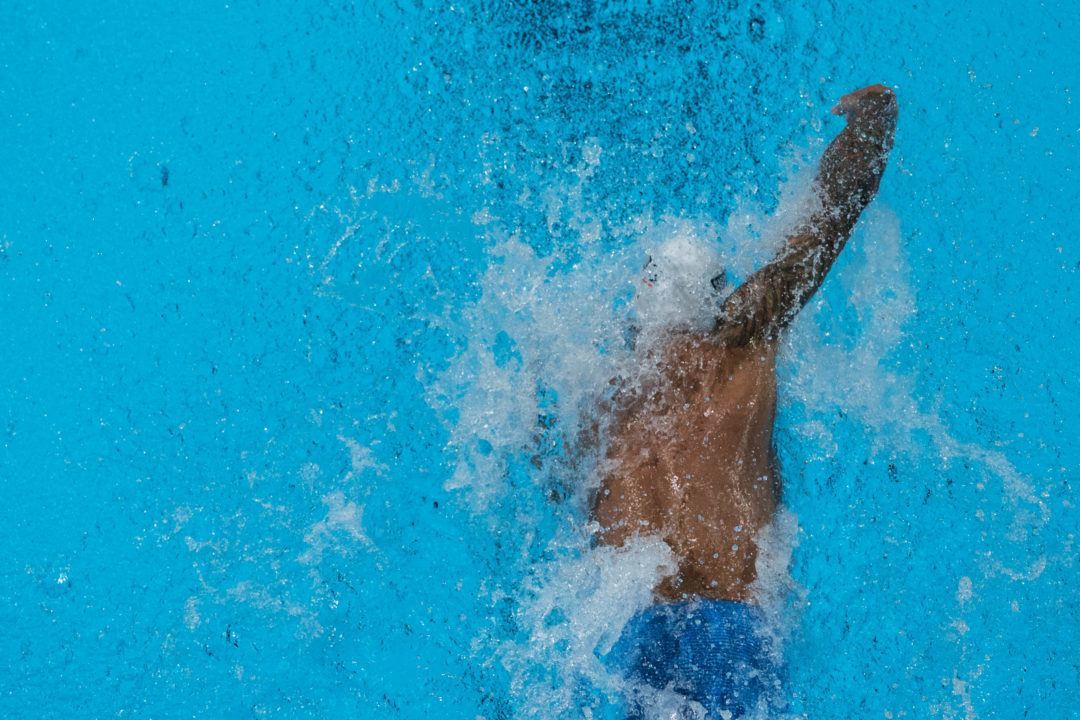Courtesy of Gary Hall Sr., 10-time World Record Holder, 3-time Olympian, 1976 Olympic Games US Flagbearer and The Race Club co-founder.
The 50-meter sprint primarily involves two of the three energy systems we have available to use. Stored energy and anaerobic energy production are the two principal ways in which we delivery ATP to our muscles for this short, all-out burst of speed. However, at the very end of the 50-meter race, when most are either won or lost, the aerobic energy system begins to kick in. Therefore, aerobic training also plays a role in the 50-meter races.
All three energy systems have the capacity to change or adapt to the environment when they are stressed in that environment over time. That simply means to improve the anaerobic systems, one must train with a method that stresses those systems. The same goes for the aerobic system.
The stored energy supply (ATP and creatine phosphate) with maximal exertion will last about 8-10 seconds. I am not certain how much more available storage of this source of energy can be developed by stressing that system (alactic training), or by ingesting creatine, which is controversial, but it can change. Alactic training is done by repeated burst maximal efforts of 8-10 seconds so as not to require anaerobic production of ATP, followed by enough recovery time to restore the stored energy supply. That time is typically around 30 seconds or so.
Developing the other anaerobic energy system, the production of ATP anaerobically (anaerobic glycolysis), which predominates the energy supply between 10 seconds up to around a minute of maximal effort, comes from what is called lactate training. This type of training includes repeated maximal effort sets of longer than 10 seconds up to one minute or so with enough recovery time so as not to overwork the aerobic system. That rest period is typically 1 to 3 minutes or more, depending on the duration of the maximal effort. This part of the anaerobic system is not improved by increasing the production rate of ATP, which is the same in trained or untrained muscles, but rather by improving the ability to buffer lactate. The release of a free hydrogen ion as a byproduct of anaerobic glycolysis results in the lowering of the pH of the body. Lactate training improves the ability of the muscle cell to remove the free hydrogen ion. The human body has a very low tolerance for changes in pH (acidification or alkalization) and if the body becomes too acidic, muscle contraction begins to diminish significantly. Athletes know this feeling all too well as the proverbial piano on the back.
The quickest and easiest way for the human to increase the pH and restore it to more neutrality is by increasing the respiratory rate, blowing off more carbon dioxide, or so-called oxygen debt. That is why swimmers do not feel the need to breathe much at the beginning of the race, but as the race progresses and the pH lowers, the swimmer cannot get enough oxygen (or blow off enough CO2).
Since the aerobic energy system (aerobic respiration or oxidative phosphorylation) comes into play at the end of the 50 meters, sprinters must also develop this system to some degree. Too much of the training required to develop this system is detrimental to the sprinter, since it often results in a degradation of good sprint technique and can shift the composition of the muscles toward an increase in slow twitch fibers used in the endurance events. Typically, sprinters will devote the earliest part of the season to developing a stronger aerobic system and the middle and end of the season toward building the anaerobic systems.
While all three of these energy systems can be improved, depending on the type of training we do, the fact is that the muscle mass and composition have a lot to do with the success or lack of success of a sprinter. The predominance of fast twitch fibers results in the ability to generate much more power than with slow twitch fibers. These types of fibers do not recover as quickly as the slow twitch variety, so sprinters cannot sustain a high speed for very long. All swimmers also have a certain number of muscle fibers that sit on the fence. They can be converted to faster twitch, resulting in more power, or slower twitch, resulting in a faster recovery rate, depending on which way the swimmer trains. Anaerobic training shifts them toward the fast side, while aerobic training shifts them toward the slow side.
Swimming is unique in that it presents a paradoxical relationship between muscle mass and speed. Because of the extraordinarily sensitive relationship between a swimmer’s morphology (build) and frontal drag, bigger does not always mean faster. In fact, in races beyond 50 meters, bigger, even if it also means stronger, often results in slower performances. Strength training in swimming remains one of the most challenging and controversial subjects because of this unique paradox.
Finally, because of the significant contribution of the kick to a swimmer’s speed, there are exceptional sprinters that do not necessarily have the expected fast twitch muscle composition, yet manage to go very fast. My son, Gary Jr, was a good example of a swimmer that did not have a great vertical leap, but still managed to win a couple of Olympic gold medals in the 50 meter freestyle. His kicking speed was incredibly fast.
In conclusion, if it is your goal to become a better sprinter, no matter what anatomical or physiological cards you were dealt, first, learn to use a sprinter’s high-octane technique. Second, train to develop the anaerobic systems, but do not completely neglect the aerobic system. You need all three. Third, build swim-specific strength outside of the pool, but don’t get too bulky. Fourth, work on developing a faster kick, where you likely have the most to gain.
If you need help in any of these areas, come visit us at The Race Club. We’d love to help you train smarter and swim faster.
Yours in swimming,
Like The Race Club on Facebook
Follow The Race Club on Instagram
Follow The Race Club on Twitter
Connect to The Race Club / Gary Hall Sr. on Linkedin
THE RACE CLUB
 Because Life is Worth Swimming, our mission is to promote swimming through sport, lifelong enjoyment, and good health benefits. Our objective is for each member of and each participant in The Race Club to improve his or her swimming performances, health, and self-esteem through our educational programs, services and creativity. We strive to help each member of The Race Club overcome challenges and reach his or her individual life goals.
Because Life is Worth Swimming, our mission is to promote swimming through sport, lifelong enjoyment, and good health benefits. Our objective is for each member of and each participant in The Race Club to improve his or her swimming performances, health, and self-esteem through our educational programs, services and creativity. We strive to help each member of The Race Club overcome challenges and reach his or her individual life goals.
The Race Club, logoThe Race Club provides facilities, coaching, training, technical instruction, video, fitness and health programs for swimmers of all ages and abilities. Race Club swim camps are designed and tailored to satisfy each swimmer’s needs, whether one is trying to reach the Olympic Games or simply improve one’s fitness. Our programs are suitable for beginner swimmers, pleasure swimmers, fitness swimmers, USA swimming or YMCA swimmers, or triathletes; anyone who wants to improve swimming skills. All of our Race Club members share an enjoyment of being in the water and use swimming to stimulate a more active mind and body.
News courtesy of The Ace Club.


I am interested In some other aspects of this:
1. how frequently should sprinters sprint in order to avoid overtraining
2. dryland aspects
I found the point about “expected fast twitch muscle composition” interesting. Anthony Ervin (based on his biggest weakness —- his start) probably doesn’t have a great vertical jump either. But I bet muscle biopsies (if you could actually do them for all these muscle groups) of Gary Hall, Jr. or Ervin would show unbelievable dominance of fast twitch muscle fibers in the pecs, forearms, lats, and hip flexors. The whole “fast twitch correlates with vertical jump” argument comes from studying land mammals, not swimmers. Who do we think could do a faster, more powerful med ball slam in their primes —- Nathan Adrian or Michael Jordan?
Perhaps….but I will discuss this question with the leading authority on muscle composition and report back. It does not seem intuitive to me that the composition of skeletal muscle would be vastly different from one skeletal muscle to the next within the same athlete, but I will find out.
According to Dave Costill, PhD, Professor Emeritus of Physiology from Ball State University, and the first to discover the different three muscle fiber types of skeletal muscle, the composition of the skeletal muscle does not change significantly from one to the next for a given athlete. The exceptions are the postural muscles (anti-gravity) that in humans, tend to be the extensor muscles. Since they need to be working at all times while we are erect, they are predominantly slow twitch fibers. Hope this helps.
It is controversial because there is limited research that says it helps or hinders. It has also picked up a bad reputation due to its use by bodybuilders. And, like any supplement, be that protein powder, vitamins and minerals, or secret sparkle dust from a special formula delivered in shiny bottles, it has been misused. There are also those who haven’t bothered to do any research on their own but make a decision about “how good” something is by only reading 20 year old data and listening to rumours.
You know, same old, same old reasons for controversy 🙂
As to your first point, creatine is probably the most studied supplement out there. Do you mean limited research as it relates to swimming? I could see that being true.
You can find any number of “studies” on creatine and athletes, fewer on it and swimming. It can have some rather bad side effects, as Coach Hall has stated. It can get misused. But it is like any supplement, in my experience. It doesn’t work for everyone, it should be extremely carefully used if at all, it isn’t a short-cut, it does NOT make you swim faster (which makes it absolutely NOT a performance aid) and there are ways to create a similar recovery now that are far better, with documented research in swimming, that are also safer and with less possible side effects. Swimming and sports nutrition supplements have moved on from creatine.
We agree!
Creatine is controversial for at least two reasons. First, has shown to have renal toxicity in some athletes, which is likely dose related. Second, it causes the muscle fiber to swell by increasing water content in the cell. While this may be good for body building, it is not good for frontal drag…so vital to fast swimming. Because of these two controversies we do not recommend Creatine at The Race Club.
Thank you for the article!
“… or by ingesting creatine, which is controversial…”
Not sure why this is controversial. It’s completely legal and has been on the market for over 20 years.